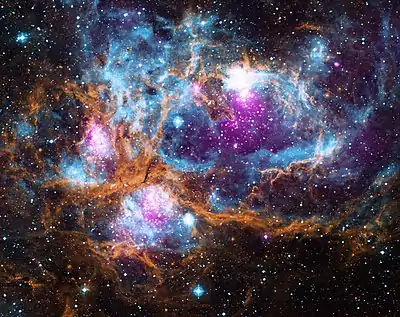NGC 6357
NGC 6357 is a diffuse nebula near NGC 6334 in the constellation Scorpius. The nebula contains many proto-stars shielded by dark discs of gas, and young stars wrapped in expanding "cocoons" or expanding gases surrounding these small stars. It is also known as the Lobster Nebula.[4][5] This nebula was given the name War and Peace Nebula by the Midcourse Space Experiment scientists because of its appearance, which, in infrared images the bright, western part resembles a dove, while the eastern part looks like a skull.[6] A petition by anime fans to rename it as the Madokami nebula, due to resemblance with a character, did not prosper.[7][8]
| Emission nebula | |
|---|---|
| H II region | |
 NGC 6357 composite image | |
| Observation data: J2000 epoch | |
| Right ascension | 17h 24m [1] |
| Declination | −34° 20′[1] |
| Distance | ~5900±450[2] ly (1800±140 pc) |
| Constellation | Scorpius[3] |
| Designations | War and Peace Nebula,[1] Lobster Nebula [4] Sharpless 11, RCW 131, Gum 66, Madokami |
It is located about ~5,500 light years away from Earth.[9]
Associated open clusters
Pismis 24


This nebula includes the open cluster Pismis 24, which is home to several massive stars. One of the brightest stars in the cluster, Pismis 24-1, was thought possibly to be the most massive on record, approaching 300 solar masses, until it was discovered to be a multiple system of at least three stars; component stars would still remain near 100 solar masses each, making them among the more massive stars on record.[10][11]
G353.2+0.7
The young stellar cluster G353.2+0.7 lies east of Pismis 24 and was revealed by a Chandra X-ray image showing approximately 800 stars.[12]
G353.1+0.6
The young stellar cluster G353.1+0.6 lies southeast of Pismis 24 and also contains approximately 800 stars detected by X-ray.[12] The region includes several O-type stars, including [BDSB2003] 10.[13]
Massive stars
NGC 6357 is one of the most prominent sites of massive-star formation in our neighborhood of the Milky Way. A variety of early O-type stars reside in this nebula, blowing the bubbles around the star clusters that can be seen in the molecular cloud.
| Star name | Spectral type | Magnitude (Mbol) |
Temperature[15] (K) |
Radius (R☉) |
Mass (M☉) |
|---|---|---|---|---|---|
| WR 93 (HD 157504) | WC7 | -11.2 | 71,000 | 10 | 120 |
| Pismis 24-1NE | O3.5 If* | −10.0 | 42,000 | 17 | 74 |
| Pismis 24-1SW | O4 III | −9.8 | 41,500 | 16 | 66 |
| Pismis 24-2 | O5.5 V(f) | −8.9 | 40,000 | 12 | 43 |
| Pismis 24-3 | O8 V | −7.7 | 33,400 | 9 | 25 |
| Pismis 24-10 | O9 V | −7.2 | 31,500 | 8 | 20 |
| Pismis 24-12 | B1 V | −5.3 | 30,000 | 4 | 11 |
| Pismis 24-13 | O6.5 III((f)) | −8.6 | 35,600 | 12 | 35 |
| Pismis 24-15 | O8 V | −7.8 | 33,400 | 10 | 25 |
| Pismis 24-16 | O7.5 V | −9.0 | 34,000 | 16 | 38 |
| Pismis 24-17 | O3.5 III | −10.1 | 42,700 | 17 | 78 |
| Pismis 24-18 | B0.5 V | −6.4 | 30,000 | 6 | 15 |
| Pismis 24-19 | B0.5 V | −5.4 | 30,000 | 4 | 11 |
See also
References
- "NGC 6357". SIMBAD. Centre de données astronomiques de Strasbourg. Retrieved 2007-05-03.
- Kuhn, Michael A.; Hillenbrand, Lynne A.; Sills, Alison; Feigelson, Eric D.; Getman, Konstantin V. (2018). "Kinematics in Young Star Clusters and Associations with Gaia DR2". The Astrophysical Journal. 870 (1): 32. arXiv:1807.02115. Bibcode:2019ApJ...870...32K. doi:10.3847/1538-4357/aaef8c. S2CID 119328315.
- R. W. Sinnott, ed. (1988). The Complete New General Catalogue and Index Catalogue of Nebulae and Star Clusters by J. L. E. Dreyer. Sky Publishing Corporation and Cambridge University Press. ISBN 978-0-933346-51-2.
- Sample, Ian (20 February 2013). "Lobster Nebula – birthplace of stars – revealed in infrared". the Guardian.
- "Lobster Nebula Seen with ESO's VISTA Telescope Space Wallpaper". Space.com. 25 February 2013.
- "2MASS Picture of the Week Archive Captions".
- "There Is A New Petition To Name A Nebula After "Ultimate Madoka"". crunchyroll.com.
- "NGC 6357. The Lobster Nebula". astrodrudis.com.
- "Winter Wonderland' Glows in Space as Nebula Is Wreathed in Wintry Colors". Space.com. 20 December 2016.
- "ESA Science & Technology: Star on a Hubble diet NGC 6357". Archived from the original on 2007-04-04. Retrieved 2007-04-11.
- Nemiroff, R.; Bonnell, J., eds. (19 December 2006). "NASA: Massive Stars in Open Cluster Pismis 24". Astronomy Picture of the Day. NASA.
- Townsley, L. K.; et al. (2014). "The Massive Star-Forming Regions Omnibus X-Ray Catalog". Astrophysical Journal Supplement. 213 (1): 1. arXiv:1403.2576. Bibcode:2014ApJS..213....1T. doi:10.1088/0067-0049/213/1/1. S2CID 76658453.
- Damke, G.; et al. (2006). "The open cluster G353.1+0.7 in NGC6357". Revista Mexicana de Astronomía y Astrofísica. 26: 180. Bibcode:2006RMxAC..26..180D.
- Fang, M.; Van Boekel, R.; King, R. R.; Henning, T.; Bouwman, J.; Doi, Y.; Okamoto, Y. K.; Roccatagliata, V.; Sicilia-Aguilar, A. (2012). "Star formation and disk properties in Pismis 24". Astronomy & Astrophysics. 539: A119. arXiv:1201.0833. Bibcode:2012A&A...539A.119F. doi:10.1051/0004-6361/201015914. S2CID 73612793.
- Martins, F.; Schaerer, D.; Hillier, D. J. (2005). "A new calibration of stellar parameters of Galactic O stars". Astronomy and Astrophysics. 436 (3): 1049–1065. arXiv:astro-ph/0503346. Bibcode:2005A&A...436.1049M. doi:10.1051/0004-6361:20042386. S2CID 39162419.
External links
- Star Forming Region NGC 6357 showing complex interactions between interstellar winds, radiation pressures and magnetic fields.
- A Massive Star in NGC 6357 with a close-up of Pismis 24.
- NGC 6357: Cathedral to Massive Stars
- A Massive Star in NGC 6357
- NGC 6357: Cathedral to Massive Stars
- NGC 6357: The Lobster Nebula